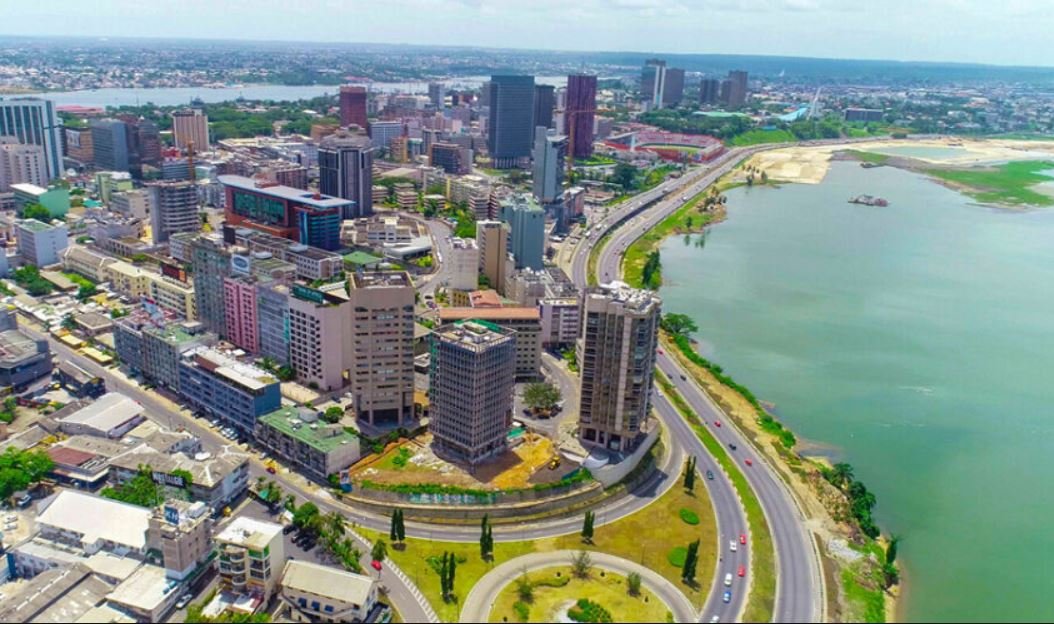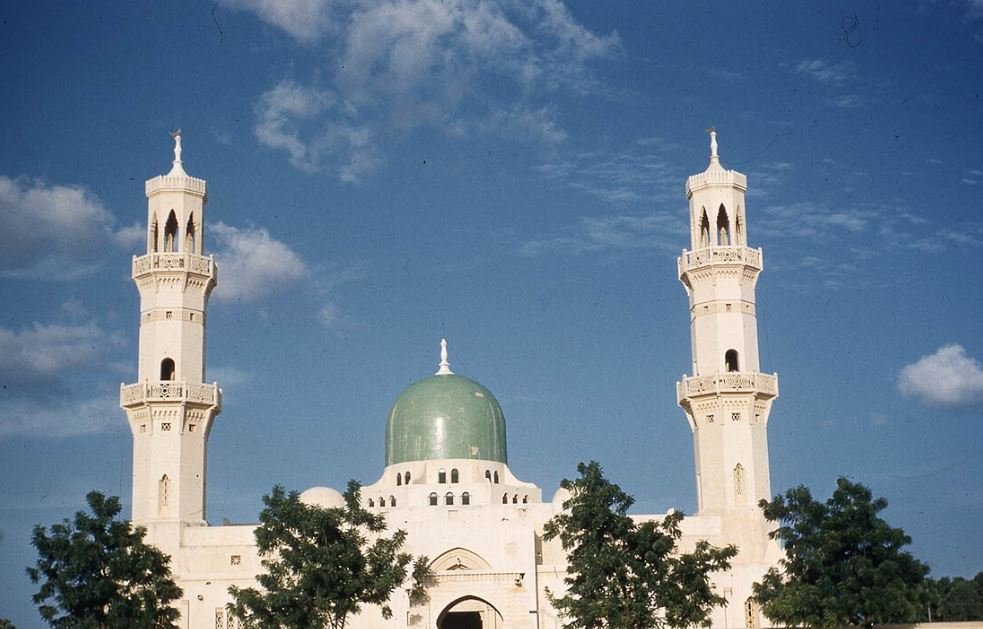
6 Biggest Mosques In Nigeria By Capacity
In this guide, you’ll learn about Nigeria’s six biggest mosques and their capacity. With millions of people visiting Mosque every day, Islam is one of Nigeria’s dominant religions, with over 90 million followers.
Some of these mosques can hold thousands of people at once. The biggest one, Abuja National Mosque, can fit 25,000 worshippers.
READ ALSO: 10 Biggest Cities In Nigeria (By Land Mass)
What Are The Six Largest Mosques In Nigeria?
Here are some of the biggest Mosque in Nigeria with their capacity:
- Abuja National Mosque – 25,000
- Yobe Central Mosque – 20,000
- Ilorin Central Mosque – 20,000
- Maiduguri Central Mosque – 15,000
- Lagos Central Mosque – 10,000
- Great Mosque of Kano – 10,000
1. Abuja National Mosque – 25,000
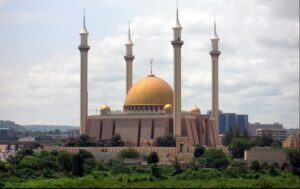
The Abuja National Mosque, also known as the Nigerian National Mosque, is the largest in Nigeria and is a central place of worship for Sunni Muslims.
Located in the capital city of Abuja, and completed in 1984, the mosque is open to the public, including non-Muslims, except during the times of congregational prayers.
The mosque is a striking example of modern Islamic architecture. It features two large domes and four towering minarets and can accommodate up to 25,000 worshippers.
The mosque is also a hub for Islamic activities and a center for religious learning. The complex includes a library, a conference room, and residential facilities for the imams and muazzins (those responsible for calling to prayer).
It also houses a conference center that can accommodate up to 600 people. The mosque is managed by a board appointed by the Nigerian Supreme Council for Islamic Affairs (NSCIA).
However, the leadership of the mosque has seen changes over the years. After the death of the chief Imam, Sheikh Musa Muhammad, in 2015, the role of Chief Imam was abolished, and a new system of leadership was established.
In 2017, Professor Shehu Ahmad Said Galadanci was appointed as the Murshid (grand instructor and spiritual guide), overseeing the mosque’s activities along with three coequal Imams. The mosque is located on Independence Avenue, directly across from the National Christian Centre.
2. Yobe Central Mosque – 20,000
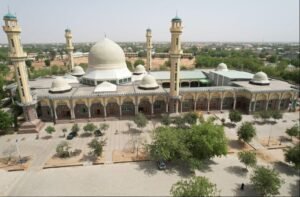
The Yobe Central Mosque, located in Damaturu, the capital of Yobe State, Nigeria, is one of the largest mosques in the country.
With a seating capacity of 20,000, the mosque is also considered one of the most important in Africa. The mosque was built in 2007 to meet the growing religious needs of the Muslim community in Yobe State.
Islam is the dominant religion in this region, and the mosque was constructed to provide a space for large gatherings and prayers.
The Yobe Central Mosque is known for its stunning architecture. It features bell-shaped domes painted in a calm olive-green color.
The mosque is also famous for its four tall minarets, which rise above the city and make it easily recognizable. It is the center for daily prayers and Islamic teachings.
During major religious events like Eid, thousands of Muslims gather there to pray together. It also serves as a venue for educational programs, fostering unity and spiritual growth in the community.
However, the Yobe Central Mosque has faced some challenges. Residents have expressed concerns about the mosque’s maintenance, as parts of the structure are showing signs of wear and tear.
READ ALSO: Top 10 Largest Catholic Churches In Africa By Capacity
3. Ilorin Central Mosque – 20,000
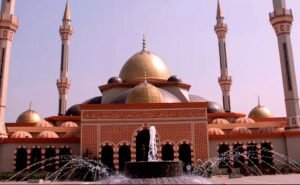
The Ilorin Central Mosque, also known as the Juma’at Central Mosque, is one of the largest mosques in Nigeria. Located in Ilorin, the capital of Kwara State, it can hold 20,000 worshippers.
This makes it the second-largest mosque in Nigeria, after the Abuja National Mosque. The history of the Ilorin Central Mosque dates back to 1820 when the first mosque was established in the area.
In 1974, the 9th Emir of Ilorin, Alhaji Zulkarnaini Gambari, commissioned the construction of a new mosque. The mosque underwent extensive renovations starting in 2007, and the project was completed in 2012, which cost about N1.95 billion, involving specialists from over 16 countries.
However, the mosque was officially opened by Vice President Namadi Sambo, with former President Shehu Shagari attending the ceremony.
The Ilorin Central Mosque is known for its beautiful and unique architectural design, with the mosque featuring golden domes, with a large golden dome that stands out above the building.
It also has four tall minarets, each reaching up to 150 feet. The overall design of the mosque is pyramid-shaped, with a square base and sloping sides.
Six gates lead to the mosque, and each gate is named after a famous Islamic scholar from the region. The interior of the mosque is just as impressive, with Islamic calligraphy and decorations.
4. Maiduguri Central Mosque – 15,000
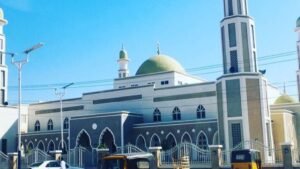
The Maiduguri Central Mosque is one of Nigeria’s largest mosques, with a capacity of 15,000 worshippers. Located in the city of Maiduguri, the capital of Borno State.
The mosque was originally built in 1918 but underwent major changes over time. In 1986, it was demolished to allow for expansion and remodeling to meet the needs of a growing Muslim population.
However, construction faced many delays and was halted for over 30 years. It wasn’t until the administration of Governor Kashim Shettima that the mosque’s renovation resumed. After years of waiting, the mosque was finally completed in 2019.
The mosque was officially opened on February 8, 2019, by the Sultan of Sokoto, Muhammad Sa’ad Abubakar III, along with over twenty other emirs and Islamic scholars.
However, the Maiduguri Central Mosque is designed not just as a place of worship but also as an Islamic resource center. It has ten classrooms, two libraries (one of which is electronic), and a media center.
The mosque also features 90 ablution points, 18 restrooms, eight water reservoirs, and a reliable power system with a dedicated transformer and two standby generators. Also, the prayer hall is spacious and equipped with modern comforts such as air conditioning and fans.
READ ALSO: When Did Nigeria Gain Independence From Britain?
5. Lagos Central Mosque – 10,000
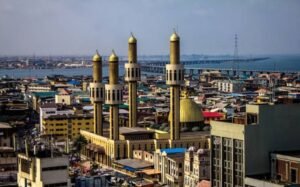
The Lagos Central Mosque is one of the fifth biggest mosques in Nigeria. It is located on Nnamdi Azikiwe Street in Lagos Island.
Also, It is the home of the Chief Imam of Lagos. The mosque was officially opened on May 28, 1988, by President Ibrahim Babangida. It replaced an older mosque that had been built between 1908 and 1913.
The original mosque, which had served the community for over 70 years, was considered outdated by some members of the mosque.
After celebrating its golden jubilee in 1963, discussions began about building a new mosque, and plans for this project were set into motion in the 1970s.
By 1983, the old mosque was demolished to make way for the new one. The new Lagos Central Mosque is a stunning modern building.
It was constructed by G. Cappa Ltd. and stands on a piece of land about one acre in size, occupying 50 meters along the busy street.
The mosque features four prominent minarets, two small ones at the entrance and two tall ones flanking the wings of the building.
And, the large prayer hall, measuring 750 square meters, is covered by a central dome made of metal and covered in gold-plated aluminum.
Under the mosque, there is a vault where the remains of deceased Imams and important community members are laid to rest.
The building also houses an office block, a reference library, an Islamic center, and an apartment for the Chief Imam.
6. Great Mosque of Kano – 10,000
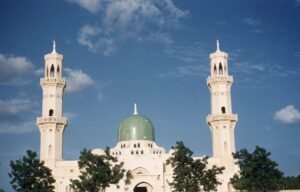
The Great Mosque of Kano, located in Kano City, is the largest in the state. With a capacity of 10,000 people, it’s the center for Friday prayers and other important Islamic events in the region.
The Great Mosque of Kano was originally built during the reign of Muhammad Rumfa, the King of Kano, who was responsible for making Islam the official religion of the city. The mosque was constructed using mud and was designed in the soro (tower) style, which was common at the time.
Before the mosque was built, Kano’s central mosque was located either in the Sharifai or Yan Doya quarters, depending on historical accounts.
These areas were known for their connection to important Islamic scholars and the Mali Empire. In 1582, the mosque was moved to a new location by Muhammad Zaki.
Then, in the mid-19th century, it was rebuilt by Abdullahi Dan Dabo after being damaged. The mosque underwent further changes in the 1950s when it was destroyed and later rebuilt with British sponsorship.
Also, the Great Mosque of Kano was the center of violent conflict in December 1980. During this time, a group called Maitatsine, known for their radical beliefs, attempted to take control of the mosque during Friday prayers.
The attack led to a violent clash between the Maitatsine group, the police, and the army, resulting in a death toll of over 4,000 people, though some reports suggest the number may have been higher.


